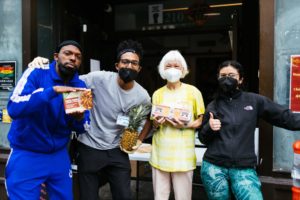
The Tenderloin Neighborhood Development Corporation (TNDC) has provided affordable housing and promoted equitable access to resources in San Francisco since its founding in 1981. Part of their mission is food justice – and that’s where our five-year partnership comes in.
Food programs span all sections of the organization. “There’s Tenderloin After School Program, Healthy Corner Stores, and Health and Wellness, which includes Healthy Aging, Food & Nutrition, and Urban Agriculture. Then there are our food pantries at our supported housing buildings. Food touches a lot of the work we do,” said Rebecca Barajas, Food & Nutrition Supervisor, TNDC.
Join us on a tour of three of TNDC’s programs to see how food justice means so much more than just providing food – and why community partners are integral to our mission to provide food for all.
Food Pantry
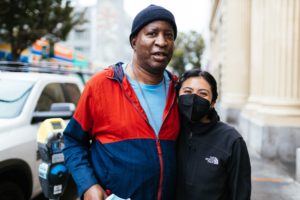
Our first stop is the food pantry on the bottom floor of TNDC’s Kelly Cullen Community, which provides supported living to seniors and people who were unhoused. We arrived to a frenzy of activity. Staff and volunteers packed grocery bags with cauliflower, milk, eggs, ravioli, and more for participants living in multiple TNDC buildings on the block.
“We open our doors to distribution at 9:15. We’ll set up tables and pack bags from heaviest to lightest – so chicken or rice would go on the bottom and something like a pear would go on top,” Rebecca told us.
“What I like is that everything’s convenient, and they have everything I need,” said a participant named Tony, grocery bag in hand.
Healthy Corner Stores
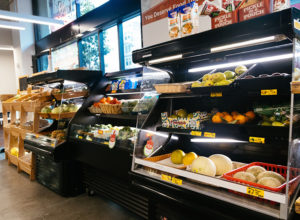
We made our way deeper into the Tenderloin to visit Dalda’s Community Market, a store that’s part of TNDC’s Healthy Corner Store Coalition. “We provide refrigeration equipment and business consulting services,” said John McCormick, Healthy Corner Store Coalition Program Manager, TNDC. “We ask the locations to limit alcohol and tobacco ads. We also promote the stores through community engagement activities, like tastings of the food.”
“People want healthy food. And we know that because people are buying it in the stores,” John told us. “Stores that aren’t part of our coalition are now selling produce because they know there’s a market for it. It totally changes the food apartheid we see here,” he said, referring to the inequitable access to nutritious food that neighborhoods like the Tenderloin have been subjected to. “Now there’s healthy produce in the neighborhood. There’s not as much of it as other places, but it’s better than it was 10 years ago.”
Urban Agriculture
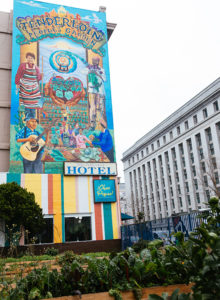
Finally, we walked a few blocks away to the Tenderloin People’s Garden, one of 14 growing spaces TNDC developed across the city. “They grow a lot – hundreds of pounds of food get distributed to our residents from the food the gardens grow,” Rebecca told us.
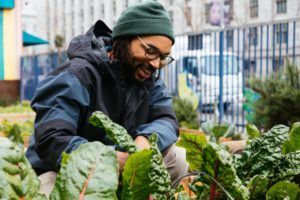
“Part of the cycle of gardens is once you start using them, they keep providing and then you have to keep using them,” said Thomas Abbott, Urban Agriculture Coordinator at TNDC. “There’s an abundance behind it.” The garden grows produce like chard, lemons, bok choy, and more alongside ornamental and aromatic plants like rosemary, jasmine, and nasturtium, which attract pollinators and predator insects that eat pests for a more natural kind of insecticide.
People who come to the gardens find an oasis. “I like when it’s like this, no trucks driving by, no ambulances. Bees and butterflies and bugs are flying around and you can hear birds chirping. Even in the middle of the city, you have some peace and quiet. It’s really a benefit for the mind. See, like that,” said Thomas as a bird broke out into song.


Share